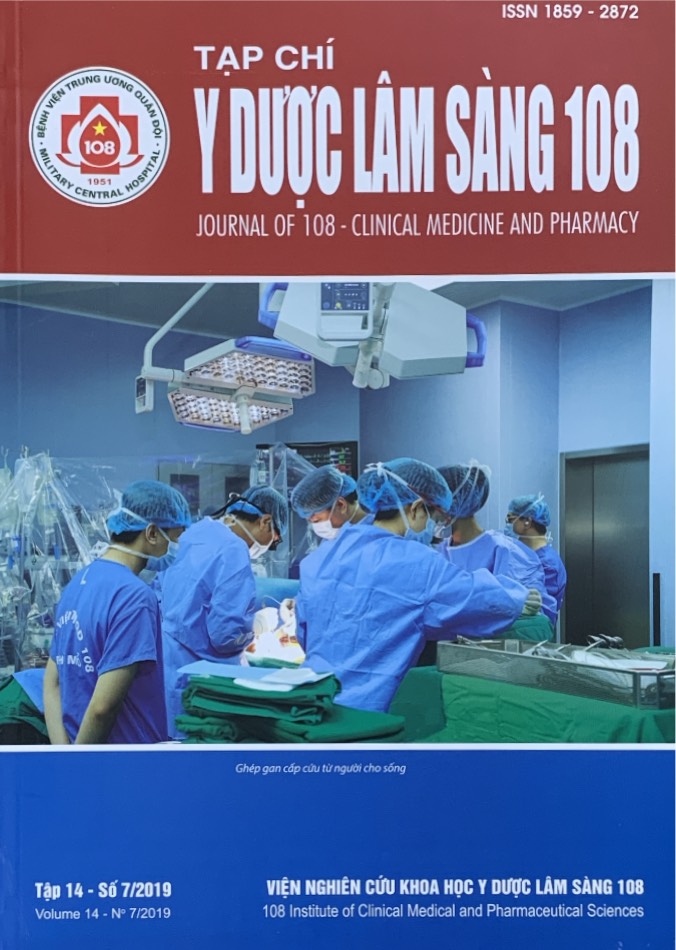Nồng độ interleukin-8 trên bệnh nhân bệnh trứng cá thông thường tại Bệnh viện Da liễu TP. Hồ Chí Minh
Main Article Content
Keywords
Tóm tắt
Mục tiêu: So sánh nồng độ interleukin-8 (IL-8) trong huyết thanh của bệnh nhân mụn trứng cá thông thường với nhóm chứng. Đối tượng và phương pháp: Nghiên cứu bệnh - chứng, trên 80 bệnh nhân và 80 người nhóm chứng tại Bệnh viện Da Liễu Thành phố Hồ Chí Minh từ tháng 11/2018 đến tháng 9/2019. Chẩn đoán mụn trứng cá thông thường dựa trên lâm sàng, phân độ nặng của bệnh GAGS. Định lượng nồng độ IL-8 huyết thanh bằng phương pháp ELISA (Enzym - Linked Immunosorbent Assay) tại Trung tâm Sinh học phân tử của Trường Đại học Y Dược Thành phố Hồ Chí Minh. Số liệu xử lý bằng phần mềm Stata 14.2. Kết quả: Nữ nhiều hơn nam, tuổi trung bình là 23 ± 02 tuổi, nhỏ nhất là 19 tuổi, lớn nhất là 29 tuổi, nồng độ IL-8 trong huyết thanh của bệnh nhân mụn trứng cá thông thường là 22,05 ± 49,89pg/ml, nhóm chứng 6,24 ± 8,45pg/ml, sự khác biệt có ý nghĩa thống kê (p<0,001), có mối liên quan có ý nghĩa thống kê giữa nồng độ IL-8 trong huyết thanh với độ nặng của bệnh (p<0,05). Kết luận: Nồng độ IL-8 trong huyết thanh ở nhóm bệnh mụn trứng cá cao hơn nhóm chứng có ý nghĩa thống kê, và có liên quan đến độ nặng của bệnh.
Article Details
Các tài liệu tham khảo
2. AI Anwar, Massi MN, Patellongi IJ, Dewiyanti W (2015) Levels of the proinflammatory cytokines: Interleukin-8, interleukin-12, tumor necrosis factor-α in severe acne at makassar. Int J Biol Med Res 6(1): 4718-4721.
3. Alicja Kucharska, Agnieszka Szmurło, Beata Sińska (2016) Significance of diet in treated and untreated acne vulgaris. Adv Dermatol Allergol 23(2): 81-86.
4. Dreno B, Gollnick HPM, Kang S et al (2015) Understanding innate immunity and inflammation in acne: Implications for management. Journal of the European Academy of Dermatology and Venereology 29(4): 3-11.
5. Beylot C, Auffret N, Poli F et al (2014) Propionibacterium acnes: An update on its role in the pathogenesis of acne. Journal of the European Academy of Dermatology and Venereology 28: 271-278.
6. Chlebus E, Chlebus M (2017) Factors affecting the course and severity of adult acne. Observational cohort study. Journal of Dermatological Treatment 28(8): 737-744.
7. Das S, Reynolds RV (2014) Recent advances in acne pathogenesis: Implications for therapy. American Journal of Clinical Dermatology 15(6): 479-488.
8. Lauren G, Jamie R, Amylynne F (2014) Perimenstrual flare of adult acne. Clinical Aesthetic Dermatology 7(8): 30-34.
9. Olga M Dеmina, Anatoly V Kartelishe, Elena I Karpova et al (2017) Role of cytokines in the pathogenesis of acne. International Journal of Biomedicine 7(1): 37-40.
10. Sabir H, Tahir I, Irfan Sadiq et al (2015) Polymorphism in the IL-8 gene promoter and the risk of acne vulgaris in a Pakistani population. Iran J Allergy Asthma Immunol 14(4): 443-449.
11. Shinjita D, Rachel V Reynolds (2014) Recent advances in acne pathogenesis: Implications for therapy. Am J Clin Dermatol 15(6): 479-488.
 ISSN: 1859 - 2872
ISSN: 1859 - 2872
